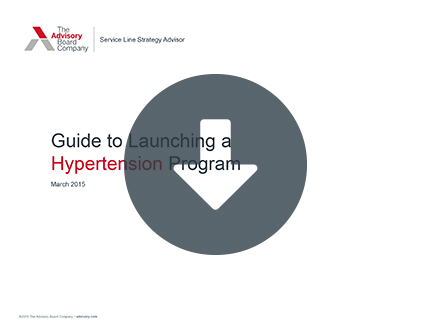Editor's note: This popular story from the Daily Briefing's archives was republished on Oct. 14, 2019.
Only about 50% to 60% of U.S. hypertension patients have well-controlled blood pressure—an "embarrassing" figure, writes Naomi Fisher, director of hypertension service and hypertension innovation at Brigham and Women's Hospital, for NEJM Catalyst.
April 10 webconference: 2019 Cardiovascular State of the Union
Here's how leading health systems have achieved much higher control rates—and what their experience can teach other providers.
The trouble with combating high blood pressure
According to Fisher, many providers treating hypertension have tried to tackle it by treating patients on a one-off basis, particularly in the wake of the 2017 update that lowered the threshold for high blood pressure from 140/90 mm Hg to 130/80 mm Hg.
But Fisher notes, "Prior performance proves control cannot be achieved solely by individual clinicians treating individual patients through traditional office visits." That's because lifestyle changes can be hard to prescribe and medication adherence rates for hypertensive patients are low.
As such, the percentage of hypertension patients across the country with controlled blood pressures sits around 50% to 60%, Fisher writes. But, she notes, some health systems have achieved controlled rates of 90% and higher—and their success holds valuable lessons.
How Kaiser and BWH have done better
For example, Fisher notes that under the old control standard Kaiser Permanente North California achieved control rates of 90%.
To achieve this, Kaiser implemented an electronic registry to identify and track hypertensive patients, as well as a treatment algorithm for providers. Hypertension patients at Kaiser also receive frequent blood pressure checks for no copay that are administered by medical assistants. Fisher writes that the use of combination pill therapy has also been key to Kaiser's success in this area.
BWH also significantly improved hypertension control rates with a dedicated program, Fisher writes. Hypertension patients at BWH have their blood pressure monitored at home and transmitted immediately into their EHR. Meanwhile, patient navigators at BWH are responsible for using an iterative clinical algorithm and communicating recommendations to patients, Fisher writes.
In a pilot of 130 patients, BWH said 91% were able to control their blood pressure in an average of seven weeks.
Toward a new national goal
"Hypertension is a global clinical problem of immense magnitude," Fisher writes. Rather than focus on the individual target, Fisher writes providers should be "focusing on control of the population."
She writes that the current 50% hypertension control rate in the United States is "embarrassing," and that an 80% target could be easily achieved with "focused attention," an 85% target could be achieved through "greater effort," and "multiple systems have proven that 90% is reachable, if we make it a priority."
"This is our moment to control hypertension on an organizational, national, even international level," Fisher writes. "Health care providers must invest up front for societal dividends that will pay off without measure" (Fisher, NEJM Catalyst, 3/5).
Your guide to launching a hypertension program
Hypertension affects 67 million American adults, but only 47% have their disease under control. Read this brief to learn how to build a program that offers patients the necessary combination of medication and lifestyle management to fight high blood pressure.
Don't miss out on the latest Advisory Board insights
Create your free account to access 1 resource, including the latest research and webinars.
Want access without creating an account?
You have 1 free members-only resource remaining this month.
1 free members-only resources remaining
1 free members-only resources remaining
You've reached your limit of free insights
Become a member to access all of Advisory Board's resources, events, and experts
Never miss out on the latest innovative health care content tailored to you.
Benefits include:
You've reached your limit of free insights
Become a member to access all of Advisory Board's resources, events, and experts
Never miss out on the latest innovative health care content tailored to you.
Benefits include:
This content is available through your Curated Research partnership with Advisory Board. Click on ‘view this resource’ to read the full piece
Email ask@advisory.com to learn more
Click on ‘Become a Member’ to learn about the benefits of a Full-Access partnership with Advisory Board
Never miss out on the latest innovative health care content tailored to you.
Benefits Include:
This is for members only. Learn more.
Click on ‘Become a Member’ to learn about the benefits of a Full-Access partnership with Advisory Board
Never miss out on the latest innovative health care content tailored to you.


